Established 2002
Lucinda Shepherd, friend Robert Randell and various experts for their support.
Roy Shepherd - a lifelong interest
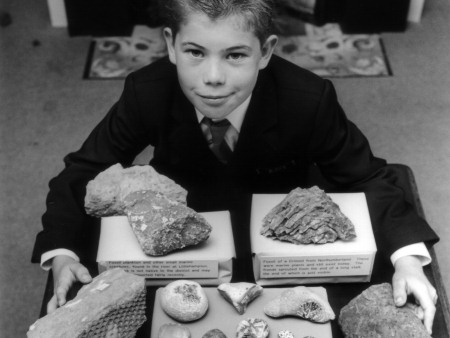
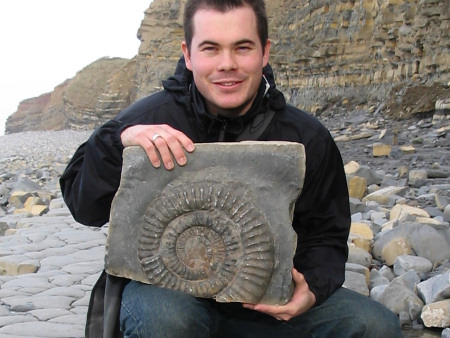
Left: Photo from the Littlehampton Gazette aged 12 with a selection of my collection. Right: A boulder containing a large ammonite from Quantoxhead.
Fossils have fascinated me for 27 years, ever since my father sparked my interest at the age of just four. I recall the memory fondly, it was 1983 and my father, Michael Shepherd, who worked as a groundsman for the Duchess of Norfolk (who lived in Arundel), had invited me to help collect firewood from the grounds of the house. I remember the excitement of driving across the grass, in and out of the trees to reach the wood; we would load as much wood as possible, carefully filling each gap with the right size roundel. Once we had filled the car we would slowly make our way back home, momentarily stopping at his work shed to put his tools back and lock up.
On one particular occasion I followed him into the shed, it was a small, dusty space, with a misty window and a damp wood smell, everything was very old. On the shelves were an assortment of tools and objects I wasn't allowed to touch, I remember asking questions about the various items I could see.
As I inquisitively gazed around the room my eyes stopped at a strange object - an oval shaped stone, golden in colour, with stripes running from top to bottom. "What's that?" I asked, "It's a Shepherd's Crown" my father replied. He said it was very old, millions of years in fact, and that things that old are called fossils. I proceeded to ask the inevitable question: "Can I have it, please?" "Yes" he said, "but only if you don't lose it!" Little did he know that quite the opposite would happen and that this fossil echinoid would be the precursor to a collection that would grow to include specimens from every corner of the country (and beyond).
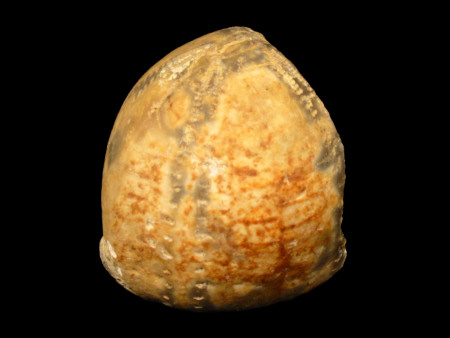
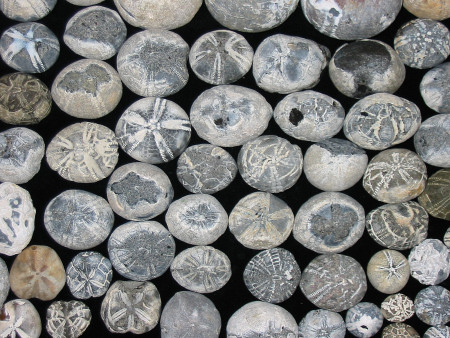
Left: My first fossil, a partial Echinocorys
echinoid
from Arundel, West Sussex. Right: A growing
collection of echinoids.
Having acquired fossil number one I was keen to find number two. Living only a short distance from the beach at Littlehampton it wasn't long before the next fossil was found and to no surprise it was another flint echinoid. We made frequent visits to the beach, in each instance returning with at least one more echinoid!
I was just 6 when my mother, Tan Shepherd, took me to visit the Natural History Museum in London for the first time. I have clear memories of the Diplodocus skeleton in the main hall, although I'm told I found equal fascination in the dozens of living pigeons amassed at the museum entrance! The incredible dinosaur skeletons and fossil displays captivated my early interest and introduced the concept that fossils weren't just confined to echinoids.
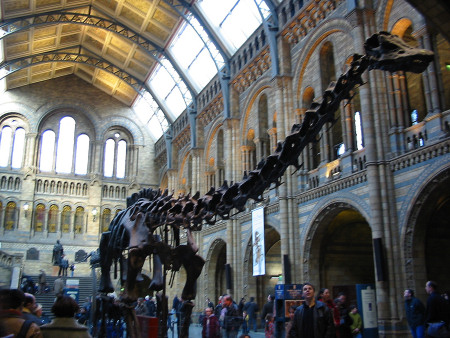
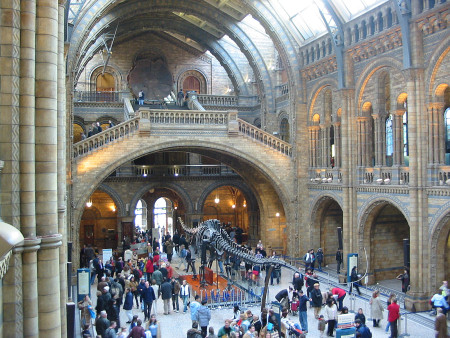
Left: A
Diplodocus skeleton in the main hall of the Natural History Museum in London.
Right: Looking towards the entrance/exit from inside the museum.
Several visits were made to the museum throughout my early childhood, some of which were with my grandmother. These visits were not always planned, on some occasions we were treated to an afternoon on the trains, with no particular agenda other than riding between stations for fun. Sometimes we would catch a connection to Brighton but 'accidentally' end up at Victoria, then make the short journey to South Kensington to see the dinosaurs!

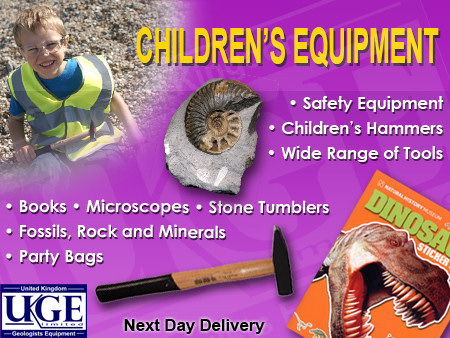
ADVERTISEMENT BY UKGE - OFFICIAL ADVERTISING PARTNER OF DISCOVERING FOSSILS
Recognising my growing interest in the subject my parents were keen to widen my experience. Over the coming years we visited a number of other fossils locations, including Kimmeridge, Whitby Bay, Bracklesham Bay and even Kielder Water, in fact a good effort was made to find fossils on any trip that happened to be near rocks!
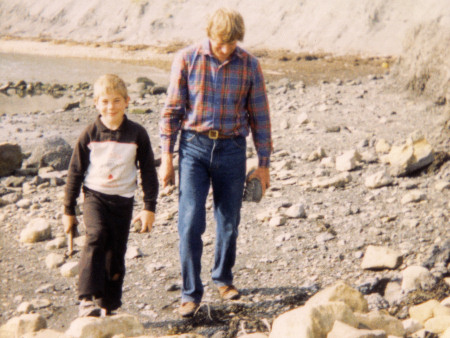
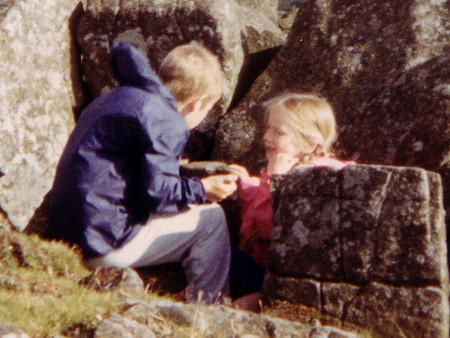
Left: Fossil hunting near Kimmeridge aged 10 with
my father Michael Shepherd. Right: Fossil hunting
with my sister Naomi Shepherd in Shropshire.
By the age of 12 my collection was well established and included a public display in the Littlehampton Museum. Among my favourite fossils on display included a section of 'tropical tree', as I knew it, from Kielder Water and some of my best echinoids from the beach at Littlehampton. The display led to a small feature in the local newspaper, which I recall feeling a sense of fame towards! To view the article click here.
Shortly after the article appeared I received a call from a local fossil collector by the name of Roy Strevens who had read about my growing interest and responded with an invitation to view his collection. This was the first time I'd heard from someone who shared my interest, so I was excited to agree a date to visit. Upon arrival (a couple of days later) we were greeted by an elderly gentleman who I guessed to be in his late seventies and invited in. On the left and right sides of the hall were doorways leading into two large rooms, each stacked with fossils from floor to ceiling! The display was awe inspiring, an Aladdin's cave of remarkable finds from around the country. I recall seeing huge ammonites and delicate ferns, and many more that I didn't recognise at all.
Over the next couple of hours Roy guided us through his collection, passionately describing what they were and where they were found; he knew each fossil by its scientific name. As our tour came to an end Roy left the room, returning moments later with a large empty crisp box. He said I could have a selection of his fossils to add to my own collection! This was fantastic, I couldn't believe my luck! He proceeded to hand me spectacular fossil after fossil to wrap with newspaper and place in the box. Two of the notable specimens included a large slab of rock containing half a dozen complete ferns and a huge chalk ammonite! The addition of this box of fossils effectively doubled the size of my collection in one afternoon - fantastic!
As the end of my school years approached it was time to decide where I wanted to specialise and eventually base my career. On the one hand I'd always considered myself a bit of an entrepreneur and on the other a keen fossil enthusiast with a desire to learn more. I eventually chose to include both Business Studies and Geography within my A-Levels and work towards a business related degree, while maintaining palaeontology as a keen interest.
In 1997 I began a four year BA (Hons) degree in Business Studies at Plymouth University. During the first year my attention was distracted by the many adventures of university and fossils took a back seat for the short time.
Then in the summer of 1998 I met someone in Littlehampton who sparked a series of events that would place fossils firmly back at the front of mind. That person was Lucinda Algar (now Shepherd) who I'll refer to as Lu from this point on.
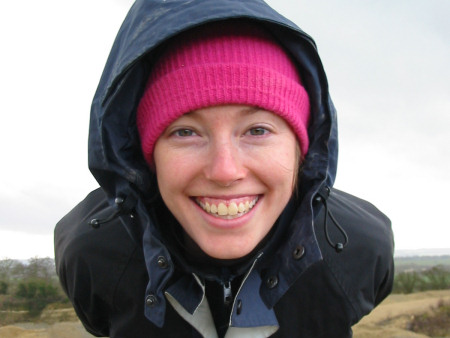
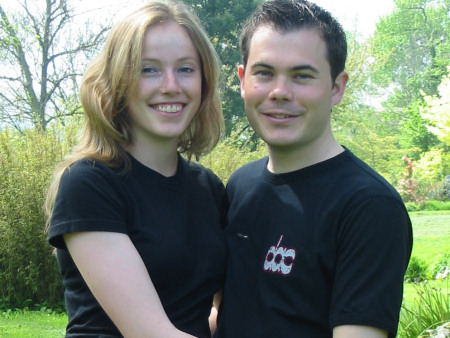
Left: Lu smiling for the camera on a cold
morning Woodeaton quarry near Oxford. Right: Myself and Lu
at Quantoxhead.
On one particular occasion Lu and I decided to take a stroll along the beach at Littlehampton. As we walked along the shingle I recalled fond memories of my early childhood. I explained how with just a little searching you could find a variety of fossils. I began by describing an echinoid. I also explained that you had to walk very slowly, scanning your eyes from left to right, trying to take in as much area as possible. Within moments and notably before I'd found an example to demonstrate, Lu casually lent down and picked up a small oval shaped pebble with five faint lines from top to bottom! It was a small, beach-worn Echinocorys echinoid. I remember how excited she was, however I'm sure a part of that was outwitting my self proclaimed expertise!
That day Lu found a further three echinoids, which brings me to an important observation that fossil collecting requires a lot of luck! For the record I did find one echinoid of my own that day! Over the coming years we made several visits to Littlehampton beach, amassing a growing collection of echinoids in the process.
Then in 2000 Lu moved from Littlehampton to begin a four year teacher training degree at the Exmouth campus of Plymouth University, which as coincidence would have it was just a short distance from the famous Jurassic coastlines of Dorset and Somerset. It wasn't until the following year that we finally had a chance to visit the neighbouring fossil localities. I had recently graduated and moved to London to begin my first job as a trainee for a consumer research company. The new start also coincided with the purchase of my first car and a new found ability to reach the country's best fossil locations.
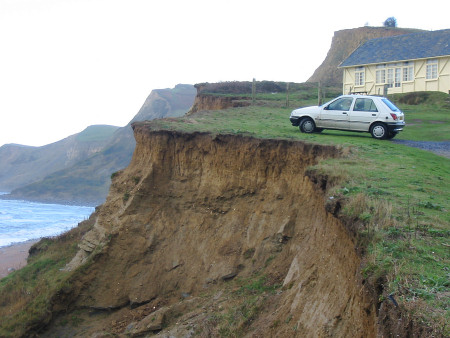
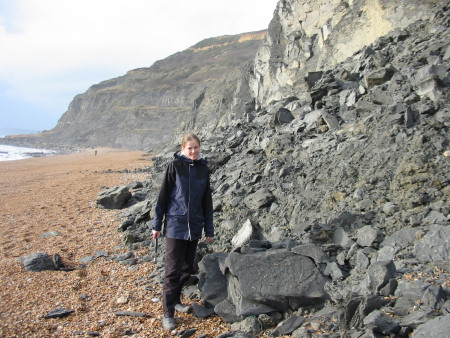
Left: My first car
(what a beauty!) enabled us to find new fossil locations. Right:
Lu searches for fossils during an early visit to
Seatown in 2002.
Every other Friday I would make the long drive from London to visit Lu in Exmouth. Our weekends were short but we often found time to visit the nearby fossil collecting locations of Lyme Regis, Charmouth, Seatown and Quantoxhead in search of fossils.
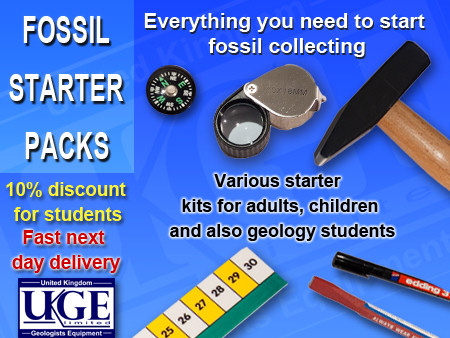
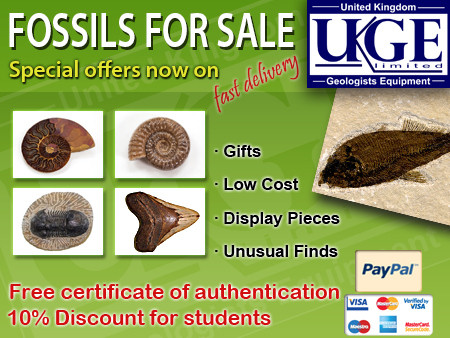
ADVERTISEMENT BY UKGE - OFFICIAL ADVERTISING PARTNER OF DISCOVERING
FOSSILS
The website is launched
In September 2002 we decided to share our experience on the internet with a modest website featuring some of our favourite locations. We called it 'Roy & Lu's UK Fossils' and it was kindly hosted by Alister Cruickshanks of UK Fossils.
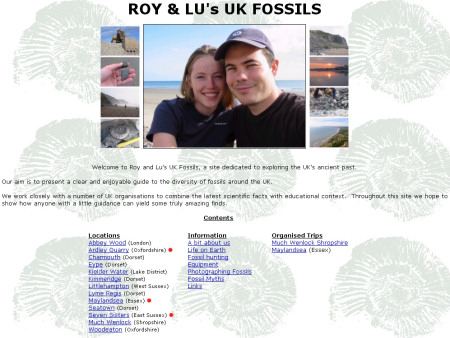
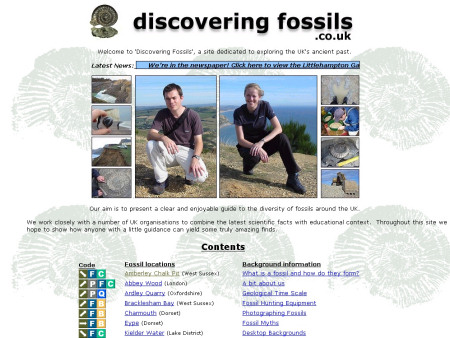
Left: In 2002 'Roy
and Lu's UK Fossils' appears online. Right: In 2003
the website was renamed Discovering Fossils and moved to
www.discoveringfossils.co.uk.
The enjoyment of running the website was heightened by our ability to track how many people were visiting each page. Since the initial month that had attracted just a handful of visitors, within just a few more the number had increased to several hundred. It was soon clear that the website required an identity that could be developed in the long-term, so in February 2003 I renamed it 'Discovering Fossils' and gave it the more suitable domain www.discoveringfossils.co.uk.
Since 2003 Discovering Fossils has grown to attract up to 3,000 daily visitors, creating countless opportunities, friends and contacts in the process. Among those people is Robert Randell who has acted as a great palaeontological mentor since 2004, providing preparation training and guidance.
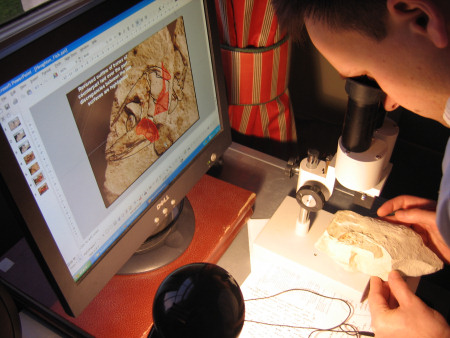
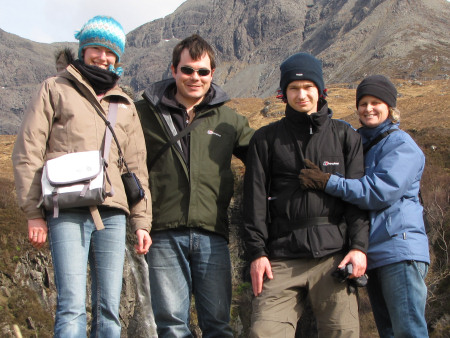
Left: Robert
demonstrates the preparation of a fish under a microscope. Right:
Our Scotland holiday in 2009, from left: Lu, myself, Robert and his wife
Denise.
In recent years I've invested much of my spare time researching and creating content for Discovering Fossils. The creation of location features in particular can each take several months to complete, requiring several field trips to photograph and document the geology and fossils.
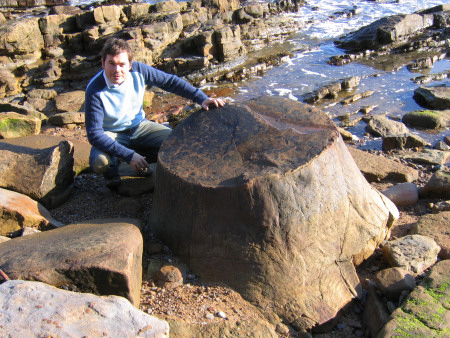
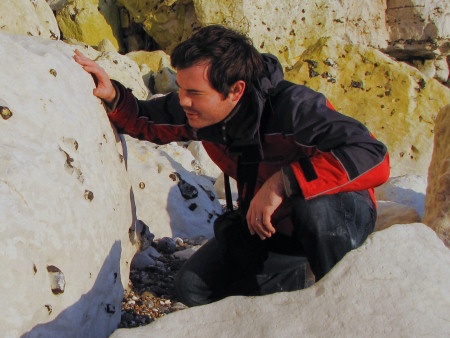
Left: Examining a
giant fossilised tree truck at
Crail in Scotland. Right:
Examining fossils on the
surface of a fallen boulder at
Seaford Head in Sussex.
One of the recent features I've added are detailed panoramics of the cliffs (where present). These diagrams begin as multiple photos spanning the cliff, these are then stitched together using image editing software. As there are often limited public resources available the task of identifying and tracing the relevant geological horizons can be a real challenge. Among the most challenging panoramics I've tackled recently was Beachy Head, which took over 4 weeks, not easy when much of the chalk cliff face is indistinguishable!

Geological panoramic of the cliffs
opposite Beachy Head
lighthouse.
![]()
Geological panoramic of the cliffs opposite Thorncombe Beacon
near Seatown.

Geological panoramic of the
Seven Sisters cliffs.
In the process of researching and writing new content for Discovering Fossils a number of further opportunities to share my enjoyment of the subject have arisen, including several tv appearances. Of these, 'British Isles a Natural History' and 'Britain's Favourite View' were among the highlights. To view some examples of my tv work click here.
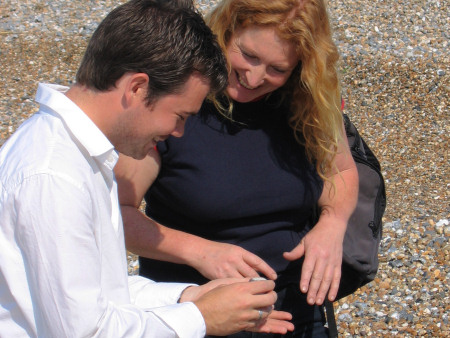
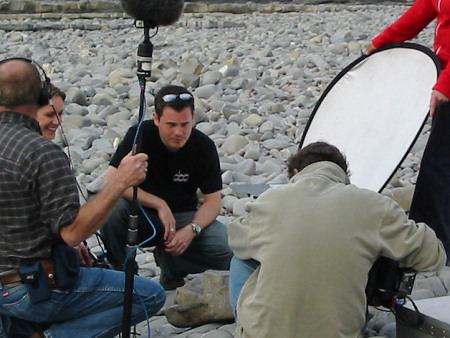
Left: Filming with
Charlie Dimmock at Littlehampton for ITV2's Walk This Way.
Right: Quantoxhead with Amanda Parr for
BBC1's British Isles a Natural History.
In the coming years I plan to continue developing Discovering Fossils, firstly by updating the early content, and then expanding the number of locations featured - I think that should keep me busy for the next few years!
I hope you enjoy the website.
Roy
Join us on a fossil hunt
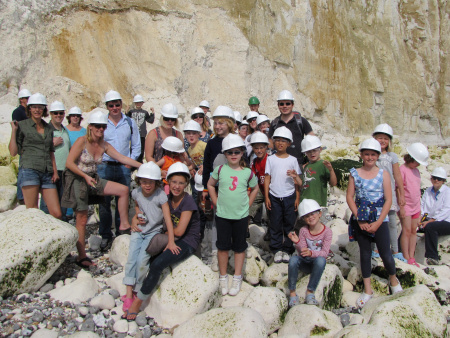
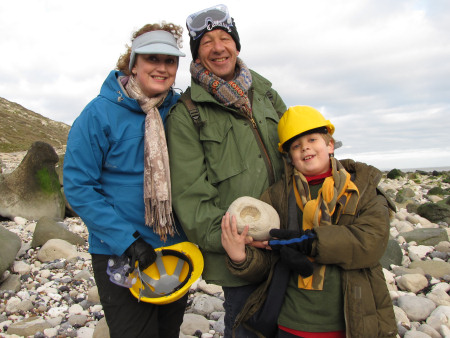
Left: A birthday party with
a twist - fossil hunting at
Peacehaven.
Right: A family hold their prized ammonite at Beachy Head.
Discovering Fossils guided fossil hunts reveal evidence of life that existed millions of years ago. Whether it's your first time fossil hunting or you're looking to expand your subject knowledge, our fossil hunts provide an enjoyable and educational experience for all. To find out more CLICK HERE




